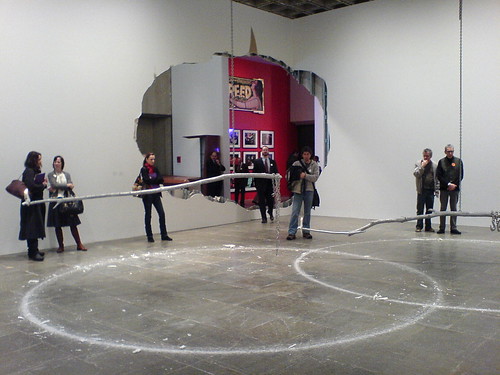Urs Fischer installation view, with Kenneth Anger's room visible in the background
James and I attended the press preview yesterday. I expect to write more, and put up some more photos, but I wanted to post some random initial impressions. Also, I can't use my catalog for reference yet since the cover fell off when I opened it and the pages haven't all been cut (oops those are fold-outs).
My first impression is that there are a lot more artists with whom I was unfamiliar, unlike the previous one. I'm pleased to see that, because I don't want the Biennial to show a lot of work that regular New York-based gallery-goers have already seen.
A number of works (such as those of Jutta Koether) were created in the spaces, with the curators indicating that the artists' responses to the Breuer building were an important part of this Biennial.
I was struck by the mention of the curators visiting Berlin to see works by young American artists. I worry very much about New York's ability to remain a cultural capital when it's so hard for artists to afford to live here. This week-old article from Crain's New York on the subject gives some statistics from a study by the Freelancers Union.
There is a great deal of political work in the show, which is fine by me, as well has heavily conceptual work. Joao Ribas has an interview on Artinfo with the curators in which they discuss the number of "anonymous" or "fictional" artists/collectives in the show. I would also say the spirit of Beuys is apparent in the show with works by Urs Fischer, JP Munro, and others.
One more observation: I found it odd that a number of works dealing with African-American issues and politics were all put together -- including works by Dawolu Jabari Anderson, Robert A. Pruitt, and Otabenga Jones & Associates. I didn't see a specific mention of a conscious choice to put these near (or next to) each other in any wall texts, but I can think of few other obvious groupings of work dealing with "identity politics" in the show.


couldn't agree more about the beuys inflluence.... but didn't you notice there was no 'form' in this biennial? no one took up the mantle on formalism, it was all disjointed or purely conceptual. which is good and interesting, but sad that according to the biennial it's not worth it being concerned with formal issues in art.
Interesting points on identity politics, it was one of the first things that jumped out at me. Politically and artistically, arranging people into separate identities is a real dead end. It creates hermetic groups that do not interpenetrate, and these small groups lack power--aesthetic power, political power.
It's one of many examples of how this show that claims to be about resistance (doesn't the Biennial site's splash screen say that together we can defeat Bush???) is actually showcasing variations on the powerlessness motif. Include a bunch of black artists making strong work, and effectively ghettoize them by putting them all together. Take a statement that was bold in 1968 (diSuvero's original Peace Tower) and trap it inside the museum. Commoditize Peace. Rail Against The Man While Being The Man.
The emperor has no clothes. No artistic merit at all.